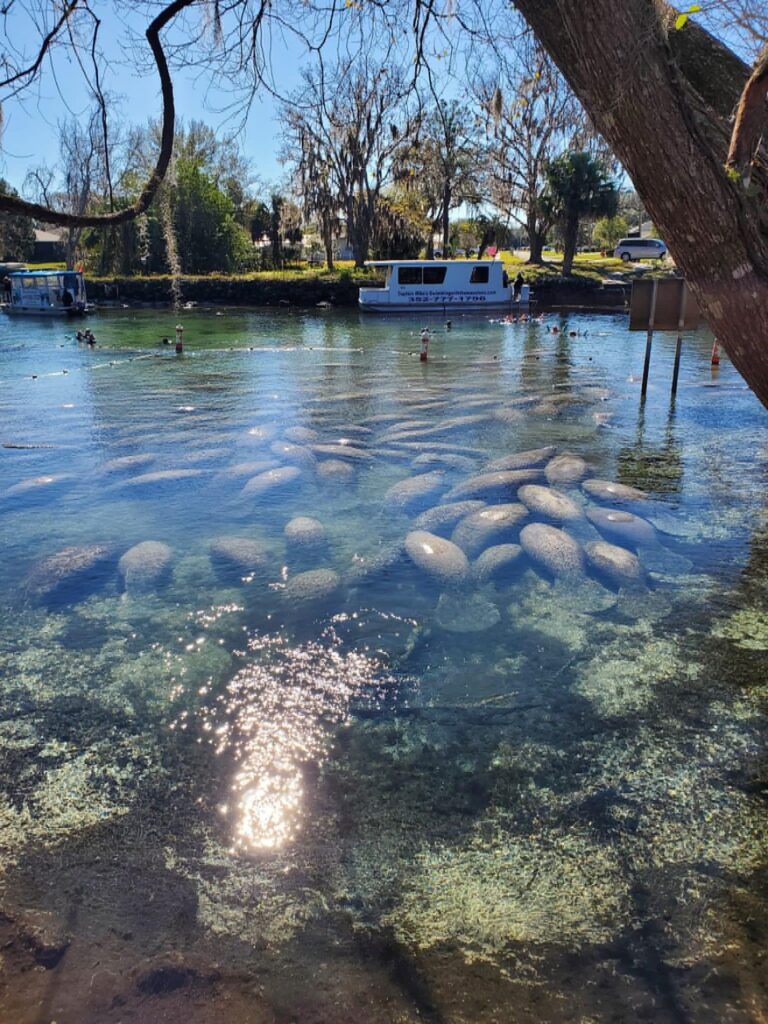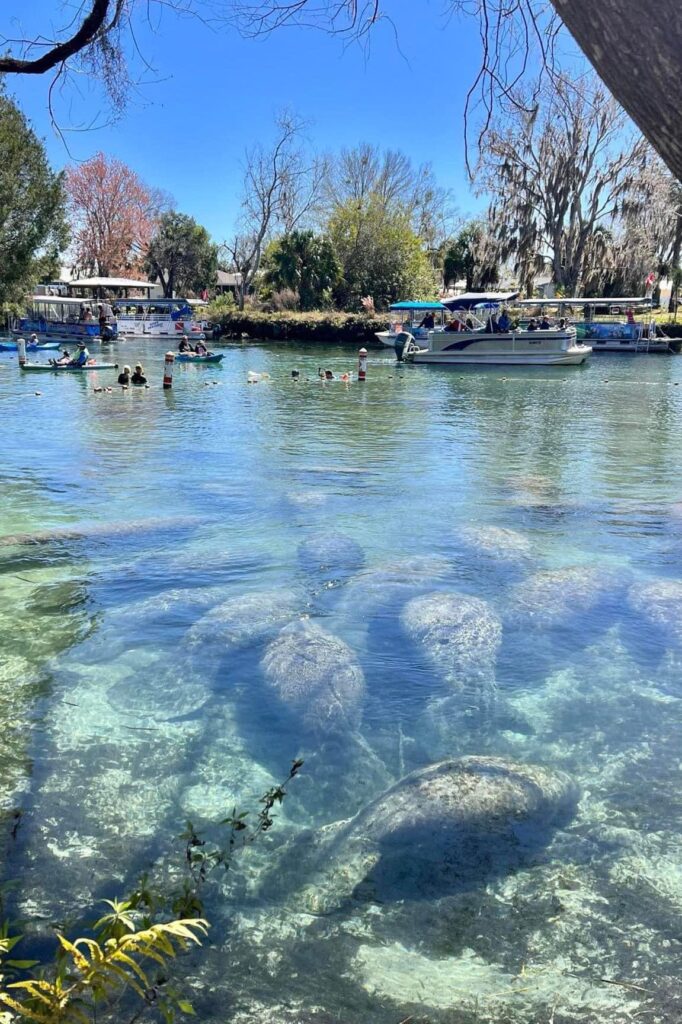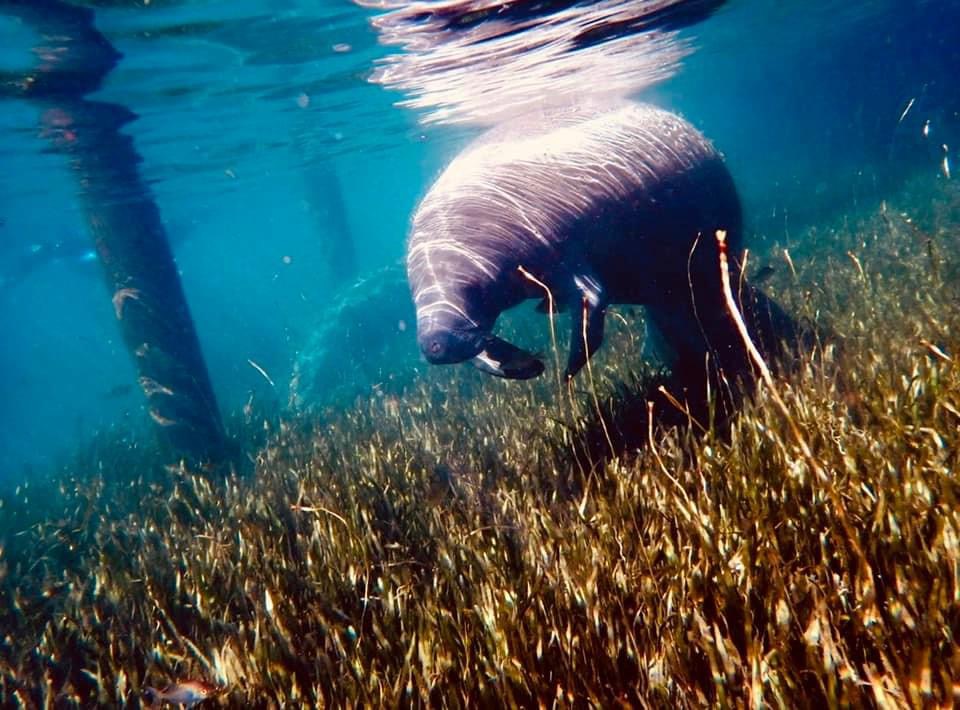Florida is well famous for its sun kissed beaches, vibrant cities and diverse wildlife,is home to a unique and enchanting creature – the Florida manatee. They are also known as sea cows.These gentle giants have been inhabiting the state’s water for centuries, attracting the hearts of locals and tourists alike. There are 7,000 to 11,000 Manatees in Florida.
In this article, we will explore the fascinating world of Florida Manatees, examining their habitats, behaviors, conservation efforts about these gentle giants.

Places to Spot Manatees in Florida
- 1. Crystal River – Up to 100 manatees
- 2.Tapron Springs
- 3. Blue Springs
- 4. Homosassa Springs
- 5. Silver Springs
- 6. Weeki Wachee
Habitats and Distribution of Florida Manatees.
Florida manatees primarily inhabit the coastal waters and the rivers of Florida,but they are also found throughout the Southeastern United States, from Texas to Virginia.
During the colder months (November to March), they are concentrated in Florida, where warm water springs and power plant outflows provide refuge from the cold.
Manatees cannot survive in the water colder than 68°F for extended periods, which makes these warm water habitats critical to their survival.
In the summer months, manatees can be found migrating further along the Gulf of Mexico and the Atlantic coast, sometimes venturing as far north as Massachusetts or west Texas.
They prefer shallow, slowly moving waters where sea grasses and other vegetation are abundant, but they can adapt to both saltwater and freshwater environments including rivers, bays and estuaries.

Physical Characteristics
1.Body size
Florida manatees can be grown up to 9-13 feet long (2.7 to 4 meters). Adults typically weigh between 800 and 1200 pounds (363 to 544 kilograms), With some individuals weighing even more.
2.Head and face
Head and face of them are wrinkled with whisker liked hairs on the snout.
3.Tail
They have paddle like a tail that they use it to swim and navigating in the water.
4.Flippers
They have flippers, they are used to swim and to navigating in the water, as well for grasping vegetation while feeding
5.Skin
Their skin is thick and grayish brown,often covered in algae, which can create a camouflage pattern in their natural habitat.
Anatomy
Manatees have several adaptations that make them well suited for aquatic lifestyle.
They have a unique respiratory system; although they are mammals and they breathe air.
Manatees have a unique ability to hold their breath up for 20 minutes while submerged, allowing them to rest or hide from predators underwater.
Lungs of manatees extend the length of their body, allowing them to control ability to float.

Reproductive System
Florida manatees reach their sexual maturity in between the ages of 3 to 5 years.
Mating occurs year round, with a peak during the spring and summer.
Females of manatees have gestation period of about 12 months, after which they give birth to a single calf, although twins can occur rarely.
Newborn manatees weigh about 60 to 70 pounds (27 to 32 kilograms) and are approximately 3 feet (0.9 meters) long.
Feeding Habits of Florida Manatees
As herbivores, manatees spend a significant portion of their day foraging for food.
They graze on sea grasses, algae and other aquatic plants, often consuming up to 10% of their body weight in vegetation daily.
Their foraging behavior involves using their flippers to uproot plants and their lips to gasp and pull vegetation towards their mouths.
Manatees are known to be selective feeders, favoring, certain species of seagrass and aquatic plants.

Social Behavior
Florida manatees are generally solitary animals, although they can be seen in small groups, particularly in areas with abundant food.
Social interactions occur during the mating seasons and mother often form strong bonds with their calves.
Manatees are known to exhibit playful behaviors such as rolling, splashing and even surfing on waves.These behaviors are thought enough to communicate with and maintain social bonds within their small groups.
Communication
Manatees communicate using a variety of vocalizations, including squeaks, whistles and chirps.These sounds are used to express different kind of emotions as distress, excitement or social interactions.
Researchers have noted that manatees may also use body language and physical touch to communicate with one another, further emphasizing their social nature.

Age & Lifespan
Manatees can live up to 60 years in the wild, though many do not reach this age due to human related threats.
Age is determined by growing rings in their ear bones, similar to tree rings.
Conservation Status
Current conservation status
Florida manatees are classified as “Threatened” under the Endangered species Act due to habitat loss, watercraft collisions
and other human related factors.
The International Union for Conservation of Nature (IUCN) list them as “Vulnerable”.While populations have seen some recovery due to conservation efforts, they still face numerous challenges that threaten their long term survival.
Major Threats
Habitat loss: Urban development,pollution and water management practices have significantly impacted to manatees habitats.
The loss of sea grass beds due to coastal development, boating activities and water quality issues poses a significant threat to their feeding grounds.
Watercraft collisions: One of the significant threats to Florida manatees is collisions with boats and other watercraft.As they often inhabit shallow, coastal waters, they are vulnerable to accidents with vessels, which can result in serious injuries of fatalities.
Cold stress syndrome: Florida manatees are warm-blooded mammals that thrive in temperatures above 68°F (20°C).When water temperature drop significantly they can experience cold stress syndrome, which can be fatal.This phenomenon has become a more pressing concern as climate change affects water temperatures and weather patterns.
Red Tides and Algal blooms: Harmful algal blooms such as red tides can produce toxins that are detrimental to manatees.
When manatees ingest toxic algae,they can suffer from various health issues,respiratory distress and neurological problems.
Boat propeller injuries: Manatees often sustain injuries from boat propellers,which can leave deep lacerations and lead to infections or death.
The scars left behind can be a visible reminder of the dangers they faced in their environment.
Conservation Efforts
Legal protections: In response to threats facing Florida manatees, various kinds of legal protections have been put in place.
The U.S. Fish and Wildlife Service oversees the management and protection of manatees under the Endangered Species Act.This legislation has led to measures aimed at reducing boat speeds in manatee habitats, protecting critical feeding and breeding areas and increasing public awareness about the importance of manatee conservation.
Rescue and Rehabilitation Programs: Several organizations in Florida, including the Florida Fish and Wildlife Conservation Commission (FWC) and the save the Manatee Club actively engage in rescue and rehabilitation efforts for injured or stranded manatees.
These organizations work tirelessly to rescue, rehabilitate,and release manatees back into the wild, providing medical care and treatment for those affected by boat strikes or other injuries.
Public Education and Awareness: Raising public awareness about the importance of manatee conservation is crucial for their protection.
Educational programs aimed at informing boaters, fishermen and the public about manatee habits and habitats help foster a sense of responsibility and stewardship for these unique gentle giants.
Initiatives like “Slow Down for Manatees” campaigns emphasize the importance of reducing boat speeds in manatee-rich areas to prevent collisions.
Manatees in Florida Culture
Florida manatees hold a special place in the hearts of Floridians and are often associated with the state’s natural beauty.They appear in various forms of art, folklore and tourism, representing the state’s commitment to wildlife conservation.
Ongoing Researches about Florida Manatees
Research on Florida manatees continues to be essential for understanding their behaviors, health, and population dynamics.
Scientists study their migration patterns, reproductive habits and the effects of environmental changes on their populations.
